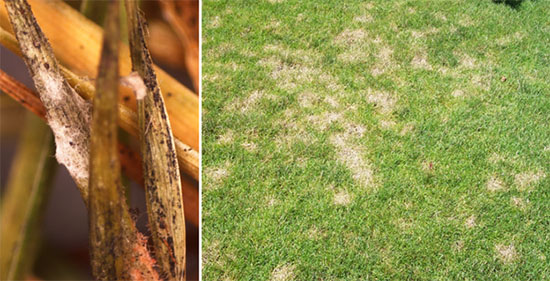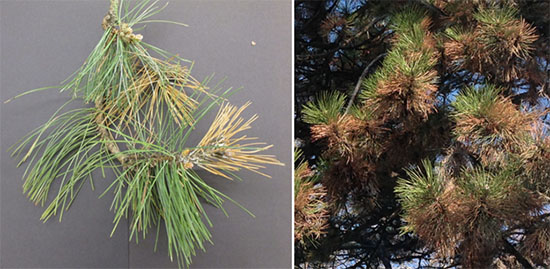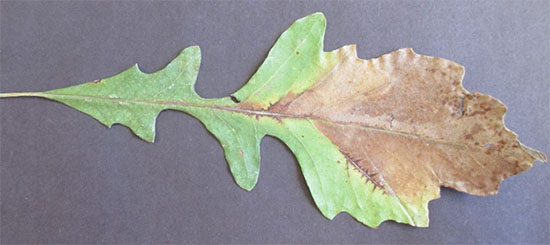Issue 18, October 19, 2015
Plant Clinic Fungi-tastic Season Wrap-Up
It's been an interesting year at the University of Illinois Plant Clinic! With the excessively wet spring and mild summer temperatures, 2015 could be called the Year of the Fungi. Bacterial and viral diseases were less common this year, probably due to the relative lack of heavy summer storms (most bacteria infect plants through wound openings) and the wet spring (most viruses spread via insect vectors, and insect populations were down probably from fungal diseases that attack insects). Damping off, root rots, and crown rots were more common than normal this spring and persisted later into the growing season than normal, while fungal leaf spots were everywhere to be seen.
Rhizoctonia, Pythium, and Phytophthora are common fungal and fungal-like root pathogens that were even more prevalent this year. Pythium and Phytophthora cause damping off and root rots and are favored by cool, wet weather, of which we had plenty. These pathogens were observed on woody and herbaceous ornamental plants, fruits, vegetables, and field crops. Rhizoctonia is most famous for causing Brown Patch and Yellow Patch in turfgrass. This year we saw a lot of those diseases, and we saw Rhizoctonia affecting ornamentals such bachelor's buttons and coneflowers.
Fungal foliar spots were everywhere this year. Forty-one of 400 woody tree samples were confirmed with anthracnose, a common leaf spot caused by various fungi. While we normally see anthracnose in spring, we saw more samples with it this year and we were finding it later into the season. For most trees, this disease is not considered a serious problem. However, in sycamore and dogwood trees, anthracnose can pose a threat to the overall health of the tree. Anthracnose was also found on herbaceous ornamentals, including hosta and English ivy.

Left: Anthracnose on English ivy. Right: Septoria on mock strawberry. Photo credit: University of Illinois Plant Clinic
Cercospora and Septoria, two common fungi known for causing leaf symptoms on field crops and vegetables, were found affecting herbaceous and woody ornamentals including creeping jenny and garden mums (Septoria) and peonies and dogwood (Cercospora). Unusual foliar issues also showed up: we identified aerial blights caused by both Rhizoctonia and Pythium. These blights only occur in situations with very high humidity and low air movement. The Rhizoctonia was found on an ornamental ground cover, while the Pythium was affecting turfgrass.
Another odd turf problem seen this year was nigrospora blight. It's rarely seen in Illinois, and only one sample was identified. More common problems on turf included rust, anthracnose, powdery mildew, ascochyta blight, and dollar spot.

Left: Nigrospora blight on turfgrass. Right: Dollar spot on turfgrass. Photo credit: University of Illinois Plant Clinic
Boxwood blight is a federally regulated pathogen that was a concern this year due to the movement of plants and the favorable weather conditions. It was not found in Illinois, though a number of common pests were, including the insects boxwood leafminer and boxwood psyllid, and the diseases Volutella blight and Fusarium blight.

Left: Leaf cupping of boxwood, a common symptom of boxwood psyllid injury. Right: Boxwood psyllid insect. Photo credit: University of Illinois Plant Clinic
We saw a large number of stress issues in woody plants. Fungal cankers, nutrient chlorosis in deciduous trees, and tip blights in conifers were the most common stress-related issues seen in 2015. Many trees are still suffering the effects of the two summers of drought back-to-back a few years ago, and the recent harsh winters and excessively wet spring have caused substantial amounts of stress to both newly-established and mature trees. Depending on the problem, management may be available that targets just the symptom or the pathogen, but the best management includes reducing stress when possible.
Both pine and spruce trees are affected with needle blights, which are also considered stress diseases. Diplodia and Dothistroma fungal diseases on pine needles were very common this year. Also common were Rhizospaera and Stigmina, two fungi which affect spruce needles. Of the 15 samples confirmed with Rhizosphaera and 14 samples confirmed with Stigmina, 8 samples were confirmed with both.

Left: Diplodia tip blight on pine. Right: Dothistroma needle blight on pine. Photo credit: University of Illinois Plant Clinic
Oak Wilt continues to be a disease of concern. This year, samples from 8 counties tested positive for the fungus. The Plant Clinic has confirmed samples from 35 counties across Illinois with Oak Wilt over the last several years. A proper diagnosis is important as the disease can quickly spread from tree to tree, and it is considered a fatal disease. While infected trees should be removed to reduce the potential spread of the fungus, it is best to wait until the tree is dormant. Proper packaging and shipping is key for an accurate diagnosis. If you suspect Oak Wilt, please refer to the Plant Clinic website for sampling guidelines or contact us.
Samples from two new counties were confirmed with Bur Oak Blight, an emerging fungal disease of Bur Oaks. A sample from a third new county is suspected of being infected with Bur Oak Blight. So far, the disease appears to be limited to northern and western Illinois, though the pathogen was only recognized in 2012 and we continue to keep an eye on this disease.

Bur Oak leaf with classic wedge-shaped necrosis characteristic of Bur Oak Blight infection. Photo credit: University of Illinois Plant Clinic
For more information about the University of Illinois Plant Clinic, including where to send samples and how to contact us, please see our website: http://web.extension.illinois.edu/plantclinic. (Diane Plewa)
Author:
Diane Plewa